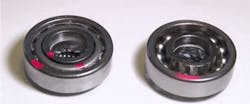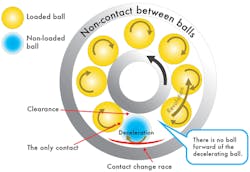Ball bearings, in use for over five centuries in a vast array of applications, provide actuation by rolling two surfaces over a layer of encaged spheres. The spheres are free to roll in place within their separate compartments, sliding the two surfaces past one another. The mechanism must be greased to reduce friction in each compartment.
Now, engineers at Coo Space Ltd. in Japan have introduced a new ball-bearing design that does not use cages. The design reduces friction and eliminates the need for lubricants. With this technology, called Autonomous Decentralized Bearings (ADB), the balls roll continuously throughout the entire system without bumping into each other. The ring ball-bearing prototype achieves this by introducing a special hole in the outer race to slightly decelerate each ball before it “catches up” with the ball in front of it.
Watch a video on the cage-less ball bearing design, courtesy of Engineering TV, below:
The design incorporates a symmetric eye-shaped hole in the outer ring, with sharp corners at the beginning and end of the hole. The ball falls deeper into the hole as it widens, and subsequently slows down. It then rolls up out of the hole as it narrows.
The ball reaches its lowest speed at the widest part of the hole. Such deceleration occurs because the sphere is rolling with a smaller circumference along the hole’s edges. This occurrence is similar to a ball that rolls slower between two rungs than it does on a flat surface. As the ball resurfaces toward the sharp edges of the hole, it speeds up again, roughly to its original speed. Meanwhile, the ball behind it is about to slow down while the other one speeds up, accounting for the spacing between each ball.
The ring-bearing prototype shows that the ADP’s smooth rotation lasts 10 times longer than that of regular, lubricated and compartmentalized ball bearings. A steel plant is currently in the process of adopting the technology.
About the Author
Leah Scully
Associate Content Producer
Leah Scully is a graduate of The College of New Jersey. She has a BS degree in Biomedical Engineering with a mechanical specialization. Leah is responsible for Machine Design’s news items that cover industry trends, research, and applied science and engineering, along with product galleries. Visit her on Facebook, or view her profile on LinkedIn.

